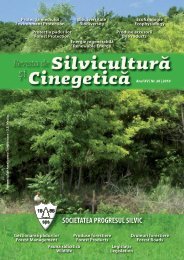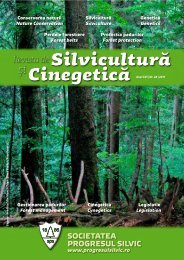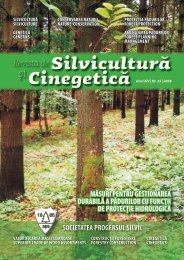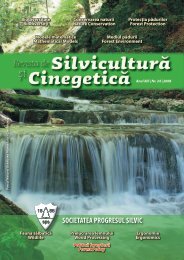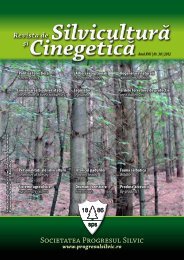Silviculture and Cinegetics Review - Societatea Progresul Silvic
Silviculture and Cinegetics Review - Societatea Progresul Silvic
Silviculture and Cinegetics Review - Societatea Progresul Silvic
You also want an ePaper? Increase the reach of your titles
YUMPU automatically turns print PDFs into web optimized ePapers that Google loves.
EDITORIAL SILVICULTURES AND CINEGETICS REVIEW XVII/30/2012<br />
Reflections at the end of the International Year of the Forests<br />
Aurel Teuşan<br />
1. The Forests of Europe: On the edge<br />
of the Ministerial Conference in Oslo<br />
1.1. Introduction<br />
„Our problems can only be solved globally“, so said<br />
Michael Prodan, Romanian professor during a speech<br />
held in October 1975 at the Faculty of Forestry of the<br />
University of Freiburg. At the same time he urged<br />
listeners to think in systems, entities that are mutually<br />
conditioned - a view that is endorsed in recent decades<br />
by the European Ministerial circles. During a first<br />
conference in Strasbourg (1990) an intra-European<br />
cooperation for common measures for the protection<br />
of forests has been established. The conference in<br />
Helsinki (1993) followed, the topic being the<br />
assurance of sustainability in matters of forest<br />
exploitation. In another conference (Lisbon 1998)<br />
were discussed the ways to meet the many functions<br />
incumbent to the forest. In Vienna (2003) the<br />
emphasis was on the responsibility of the partners <strong>and</strong><br />
in Warsaw (2009) on the qualitative aspect of forest<br />
resources. The cycle of conferences culminated during<br />
the International Year of the Forests with a statement<br />
in Oslo in June 2011 to which contributed several<br />
organizations, namely Forest Liaison Europe,<br />
UNECE, FAO <strong>and</strong> EFI (European Forest Institute).<br />
The topic, „State of Europe’s Forests“, is conclusive<br />
<strong>and</strong> it is conceivable as the new starting point to<br />
optimize the European forestry.<br />
The ultimate objective in the management <strong>and</strong><br />
exploitation of forests is defined as follows:<br />
- Ensuring biodiversity, productivity, natural<br />
regeneration <strong>and</strong> vitality.<br />
- Also transposing in the position that meets the socioeconomic<br />
<strong>and</strong> ecological requirements not only<br />
locally but nationally <strong>and</strong> globally. In short:<br />
sustainable management. Condition sine qua non:<br />
adjacent ecosystems are not affected. Wishing to<br />
emphasize the differences between regions, Europe<br />
was divided into six subunits, namely North, Central -<br />
West, Central - East, Russian Federation, South - East,<br />
South - West. The basic data come from the 46<br />
Member States <strong>and</strong> were obtained through both a<br />
questionnaire <strong>and</strong> the European statistics.<br />
The needed information was unavailable in some<br />
cases. The available data was divided into two<br />
chapters. These, in turn, have several subdivisions that<br />
we will briefly reproduce.<br />
1.2. Quantitative elements<br />
- Forested area in Europe amounts to 10.2 million km<br />
2 or 25% of the total world. In the last 20 years forest<br />
area increased in all 6 regions with 0.8 ha annually.<br />
- Wood reserves have increased over the same period<br />
by 8.6 billion cubic meters from where a gap between<br />
the increased surface <strong>and</strong> the reserves in wood.<br />
Europe has the second place after South America.<br />
Average per hectare varies between 158 m.c.<br />
(European Union) <strong>and</strong> 105 m.c. the rest of Europe.<br />
- Storage capacity of carbon dioxide. Between 2005<br />
<strong>and</strong> 2010 European forests have incorporated 870<br />
million tons annually, a figure equal to 10% of the<br />
total gas emissions.<br />
- Vitality of forest ecosystems. The main criterion is<br />
the tree crown. In 2009 one quarter of the control trees<br />
had thinning crown. The trees attacked by insects,<br />
fungi <strong>and</strong> animals in Europe amount to 11 million<br />
hectares or 1%. Sulfur deposits decreased by 30%<br />
over the past decade.<br />
- The balance between annual growth <strong>and</strong> exploitation<br />
is positive. In 1990 only 51% of the growth were<br />
exploited, a rate which in 2010 reached 62%.<br />
- Roundwood production. In this field, Europe is<br />
primus inter pares in the world. In the year 2010 over<br />
578 million cubic roundwood were collected, revenue<br />
amounted to 21.1 billion Euros.<br />
- Other products (Christmas trees, fruit, berries, bark).<br />
The reports obtained show a gain of 27 billion Euros.<br />
Other details are difficult to obtain.<br />
- The forest as workplace. Beginning with 2007 a<br />
constant annual income of 818 Euros was made.<br />
- Biological Diversity. Some methods of forest<br />
management, including promoting the natural<br />
regenerations <strong>and</strong> mixed forests, can help improve this<br />
sector.<br />
- Natural forests. At European level natural forests<br />
(26%) are found only in the mountain regions of<br />
northern <strong>and</strong> eastern Europe.<br />
- Forests with protective functions (soil, water) totalwithout<br />
Russia - 20%.<br />
6



